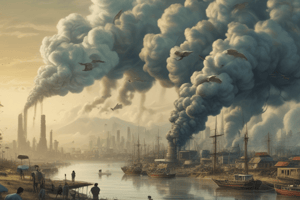Podcast
Questions and Answers
What is the primary responsibility recognized by the state in addressing environmental problems?
What is the primary responsibility recognized by the state in addressing environmental problems?
- The central government is the primary authority for all environmental issues.
- Local government units are primarily responsible for addressing environmental problems. (correct)
- Each citizen is responsible for managing environmental concerns independently.
- The state believes that environmental issues should be managed by international organizations.
Which principle emphasizes that environmental protection is a collective responsibility?
Which principle emphasizes that environmental protection is a collective responsibility?
- The right to a balanced ecology is only for urban areas.
- Only industries that cause pollution are responsible for environmental cleanliness.
- A clean and healthy environment should be the concern of all individuals. (correct)
- Environmental issues should be addressed solely by government authorities.
What overarching goal does the Philippine Clean Air Act of 1999 promote?
What overarching goal does the Philippine Clean Air Act of 1999 promote?
- Strict international environmental control policies.
- Sustainable development that includes local ecological harmony. (correct)
- Individual rights over environmental regulations.
- Maximizing urban industrial activities.
What does the declaration of policies aim to balance?
What does the declaration of policies aim to balance?
Which concept does the phrase 'polluters must pay' illustrate in the context of this act?
Which concept does the phrase 'polluters must pay' illustrate in the context of this act?
Which statement best describes 'air pollution'?
Which statement best describes 'air pollution'?
What is excluded from the definition of 'air pollutant'?
What is excluded from the definition of 'air pollutant'?
What are ambient air quality guideline values primarily used for?
What are ambient air quality guideline values primarily used for?
How is 'ambient air quality' defined?
How is 'ambient air quality' defined?
What is the purpose of the 'Certificate of Conformity'?
What is the purpose of the 'Certificate of Conformity'?
What are greenhouse gases known for?
What are greenhouse gases known for?
The term 'hazardous substances' primarily refers to which type of risks?
The term 'hazardous substances' primarily refers to which type of risks?
Which of the following accurately describes 'emission'?
Which of the following accurately describes 'emission'?
What does an 'eco-profile' evaluate?
What does an 'eco-profile' evaluate?
Which of the following is NOT considered a part of air pollutants?
Which of the following is NOT considered a part of air pollutants?
Flashcards are hidden until you start studying
Study Notes
Overview of the Philippine Clean Air Act of 1999
- Enacted on June 23, 1999, as Republic Act No. 8749.
- Aims to establish a comprehensive air pollution control policy in the Philippines.
Declaration of Principles
- Emphasizes the right to a balanced and healthful ecology for all citizens.
- Advocates for sustainable development with local government units playing a primary role in environmental management.
- The principle "polluters must pay" is recognized, ensuring accountability for environmental damage.
- Promotes collective responsibility for maintaining a clean and healthy environment.
Policy Framework
- Pursues a balance between development and environmental protection.
- A framework for sustainable development is to be followed, considering the ecological impact of activities.
Recognition of Rights
- Citizens' rights regarding a healthy environment are acknowledged and aimed to be guaranteed.
Definitions of Key Terms
- Air Pollutant: Any harmful matter in the atmosphere excluding natural gases like oxygen and nitrogen.
- Air Pollution: Changes to the air's physical, chemical, or biological properties that harm health or the environment.
- Ambient Air Quality Guideline Values: Concentration values for air quality that aim to protect public health, helping in monitoring and controlling air quality.
- Ambient Air Quality: Refers to the overall pollution levels in a broad area, indicating general atmospheric purity.
- Certificate of Conformity: Issued by the Department of Environment and Natural Resources, certifying that a vehicle meets air quality standards.
- Eco-profile: A geographic tool that assesses environmental quality and the carrying capacity of an area using integrated data.
- Emission: Any air contaminant or unwanted sound released from a source into the atmosphere.
- Greenhouse Gases: Gases like carbon dioxide and methane that contribute to global warming.
- Hazardous Substances: Substances posing acute or chronic health hazards, including toxic and carcinogenic risks.
Studying That Suits You
Use AI to generate personalized quizzes and flashcards to suit your learning preferences.




